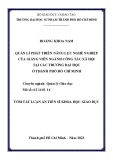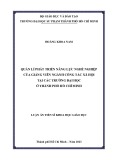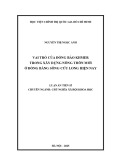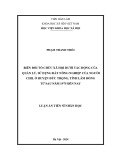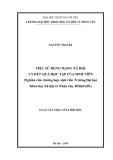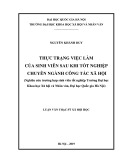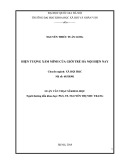MINISTRY OF EDUCATION AND TRAINING
THE UNIVERSITY OF DANANG
PHẠM THỊ QUỲNH NHƯ
A CRITICAL DISCOURSE ANALYSIS ON ABSTRACTS OF EDUCATION JOURNAL ARTICLES IN ENGLISH AND VIETNAMESE
Field: The English language
Code: 60.22.02.01
MASTER THESIS IN SOCIAL
SCIENCES AND HUMANITIES
(Summary)
Da Nang, 2016
The thesis has been completed at
THE UNIVERSITY OF DANANG
Supervisor : Assoc. Prof. Dr. LƯU QUÝ KHƯƠNG
Examiner 1: NGUYỄN TẤT THẮNG, Ph.D
Examiner 2: TRẦN HỮU PHÚC, Ph.D
The thesis orally defended at The Examining Committee.
Field: The English language Time: 26th December, 2016 Venue: The University of Danang
The thesis is accessible for the purpose of reference at: - Information Resource Center, the University of Da Nang - The Library of University of Foreign Language Studies, The University of Da Nang
1
CHAPTER 1 INTRODUCTION
1.1. RATIONALE
Language is one of the greatest inventions that mankind has ever
made. It plays a crucial role in all aspects of our lives. Ideas and
understanding available through language shape our practice in a
various way in everyday interactions. In addition, language helps us
express our inner thoughts or feelings as well as maintain the social relationships. A wide range of studies were conducted in terms of applied linguistics and critical discourse analysis (henceforth CDA)
is one of the crucial approaches of discourse analysis.
In addition, linguists and researcher in fact have conducted a
noticeable number of studies in terms of educational discourse.
However, studies on educational discourse from perspective of CDA,
to some extent, seem to be minor in the number. The thesis hopes to
discover and prove how effective language is used to transfer ideas,
affect people„s perception about things in education in particular and
affect society in general. Therefore, in this paper, I would like to
examine abstracts from educational journal articles in English and
Vietnamese.
1.2. AIMS OF THE STUDY
The aims of this research is to examine the textual description in
terms of vocabulary analysis, grammar analysis, textual structure
within the framework of CDA in abstracts from education journal
articles (EJAs) in English and Vietnamese as well as find out the
similarities and differences of textual description between English
and Vietnamese abstracts of EJAs. This study also helps Vietnamese
2
learner of English grasp the distinctive characteristics in writing style
between English and Vietnamese EJAs in order to write articles with
highly persuasive communication values.
1.3. OBJECTIVES OF THE STUDY The study is intended to:
- To examine the textual description in terms of vocabulary
analysis, grammar analysis and textual structure in abstracts of EJAs
in English and Vietnamese in CDA perspective.
- To find out and explain the similarities and differences of
textual description in terms of vocabulary analysis, grammar analysis
and textual structure in abstracts of EJAs in English and Vietnamese
in CDA perspective.
1.4. RESEARCH QUESTIONS
The study attempted to answer the following research
questions:
1. What are the textual description in abstracts of EJAs in
English and Vietnamese in terms of vocabulary analysis, grammar
analysis and textual structure in CDA perspective?
2. What are the similarities and differences of textual
description in terms of vocabulary analysis, grammar analysis and
textual structure between English and Vietnamese abstracts of EJAs
in CDA perspective?
1.5. SCOPE OF THE STUDY
The focus of this thesis is on the textual description in terms of
vocabulary analysis, grammar analysis and textual structure of
abstracts in EJAs basing on CDA. This study follows only the
description stage according to Fairclough‟s framework. The
interpretation and explanation stages were not included because the
3
nature of „analysis‟ changes from stage to stage. In the case of
description, analysis is generally thought of as a matter of identifying
and 'labelling' formal features of a text in terms of the categories of a
descriptive framework. In the case of interpretation, it is the cognitive
processes of participants, and in the case of explanation, it is
relationships between transitory social events (interactions).
1.6. ORGANIZATION OF THE STUDY
CHAPTER 2 LITERATURE REVIEW AND THEORETICAL BACKGROUND 2.1. REVIEW OF PREVIOUS STUDIES RELATED TO THE
RESEARCH
Critical discourse analysis begins to take hold in educational
research in North America (Siegel & Fernandez 2000) for an
overview of critical approaches. Educational researchers are
interested in how text are put together (Bloome & Carter 2001,
Lemke 1992, Peyton – Young 2001), studies of policies (Collins
2001, Corson 2000, Woodside –Jiron 2002, in press) and interactions
in classrooms and schools (Bloome &Egan – Robertson 1993, Rogers
2003). All of these studies are linked in order to figure out the
relationship between language and social configurations of education.
Researchers using CDA show their concerns in critical theory of the
society, the relationship between language and discourse which leads
them to conduct the description, interpretation and explanation for
such relationships.
Roger (2005) (setting an agenda for critical discourse analysis in
4
education) tried to explicitly comment on the intersections between
the two CDA frameworks of Gee (2001) in “An Introduction to
Discourse Analysis” and Fairclough (1989) in “Language and
power” to allow the theory and method of CDA to be reformulated
and applied to important educational issues. Luke (2005) described
the historical contexts and theoretical precedents for sociological
models for the study of language, discourse and text in education.
The authors outlined key terms, assumptions and practices of critical
discourse analysis. Describing unresolved issues and challenges for
discourse analysis and sociology of education are also the main point
the reader can conclude from this article.
Nguyen Hoa (2006) has made a great contribution to CDA and
created the impetus to this field. More recently, Do Thi Xuan Dung
(2014) gave an insight into how to use CDA to analyze slogan in
Vietnamese and English, and came to the conclusion that discourse
was not only a social custom, but also a social and cultural face. The
supported relationship between the language functions in social
interactions with the impact of the language on this relationship
proved that language is inseparable part of the reality, as well as
social practices tend to rely on language dramatically. In addition, in
Viet Nam, the study of critical discourse analysis (CDA) were also
presented in many master theses and one of the representative is the
thesis of Tran Thi Long (2013) with the title “Critical discourse
analysis of the education talks by Sr. Robinson”. The thesis is a
critical discourse analysis of the talks ―schools kill creativity and
―bring on the learning revolution by Sir Ken Robinson in TED
conferences. The thesis aims at exploring the relations among
language, power and ideology manifested in two of these talks.
5
However, none of them conducted their research on discourse
features of abstracts of EJAs. Thus, “Critical discourse analysis on
abstracts of education journal article in English and Vietnamese”
was conducted with the aim of contributing a minor part to this field. 2.2. THEORETICAL BACKGROUND
2.2.1. Concepts of Discourse Analysis 2.2.2 Critical Discourse Analysis (CDA) a. Concept of CDA
b. Main Approaches to CDA
2.2.3 Fairclough’s Analytical Framework Fairclough offers a three - dimensional model for CDA
consisting of three inter-related processes of analysis tied to three
inter-related dimensions of discourse (Rogers, Berkes, Mosley, Hui,
and Josep, 2005: 371). These three dimensions of discourses are: text
(description: formal prosperities of the text), discourse practice
(interpretation: relationship between text and interaction), and
sociocultural practice (explanation: social determination of the
processes of production and interpretation and their social effects).
As mentioned by Fairclough (1989), his analysis is on the basis
of three elements including description, interpretation and
explanation. Linguistic characteristics of texts are described, the
relationship between the productive and interpretative processes
of discursive practice and the texts is interpreted, and the relationship
between discursive practice and social practice is maintained
(Fairclough, 1995).
In doing this, Fairclough attempts to establish a systematic
method for exploring the relationship between text and its social
context. Fairclough subsequently gives three stages of CDA, which
6
are in accord with the three above mentioned levels of discourse.
Description is the stage which is concerned with the formal
properties of the text.
1. What experiential values do words have?
- What classification schemes are drawn upon?
- Are there words which are ideologically contested?
- Is there rewording or overwording?
- What ideologically significant meaning relations (synonym,
hyponym, antonym) are there between words?
2. What relational values do words have?
- Are there euphemistic expressions?
- Are there markedly formal or informal words?
3. What expressive values do words have?
4. What metaphors are used?
5. What experiential values do grammatical features have?
- What types of process and participant predominate?
- Is agency unclear?
- Are processes what they seem?
- Are nominalizations, active/ passive sentences, and positive/
negative sentences used?
6. What relational values do grammatical features have?
- What modes (declarative, grammatical question, imperative) are
used?
- Are there important features of relational modality?
- Are the pronouns we and you used? And if so, how?
7. What expressive values do grammatical features have?
8. How are sentences linked together?
- What logical connectors are used?
7
- Are complex sentences characterized by coordination or
subordination?
- What means are used for referring inside and outside?
9. What interactional convention are used?
- Are there ways in which one participant controls?
10. What larger scale structures does the text have?
2.2.4. Systematic Functional Grammar (SFG) and its roles
2.2.5. Abstracts of Education Journal Articles (EJAs)
2.3. SUMMARY
CHAPTER 3 RESEARCH DESIGN AND METHODOLOGY
3.1. RESEARCH METHOD
The design of the thesis was based on combining qualitative and
quantitative approaches. The descriptive method, analytic method
and comparative method were also employed in this research.
Firstly, the descriptive and analytic method were used to describe
and analyze collected data in order to find out textual description
features (vocabulary, grammar, textual structure and its values such
as experiential, relational and expressive value) which followed the
theory of discourse analysis and the framework of CDA.
Next, the results were categorize according to its similar or
different features which supports the discussion section.
3.2. DESCRIPTION OF POLUATION AND SAMPLES
The population of the study consists of 200 abstracts from
educational journal including 100 in English and 100 in Vietnamese
abstracts collected from 2 educational articles in 2 websites:
8
- www.eric.ed.gov
- www.giaoducthoidai.vn
- The content of the abstract has to be relevant to the field of
education management in both English and Vietnamese.
- The average length of each abstract varies from 250 words to
300 words. After totally 620 EJAs were examined, the number of
EJA with average length below 250 words and over 300 to 800 words
only takes up 4% and 27% respectively.
- The number of 200 samples used in this research is entirely
satisfactory owing to the fact that in total of 620 abstracts in EJA in
English and Vietnamese, there are over 100 samples corresponding
the suitable length within research and their content related to
educational development topics.
Vietnamese website was the only original website of Ministry of
Education and Training written in Vietnamese format that suited the
requirement while English website was the cutting-edge education-
related resources available for research and practice that was
controlled by the U.S Department of Education.
3.3. DATA COLLECTION
To collect sufficient and appropriate data for the study, I followed
the steps. Firstly, I searched for sources of journal article having
abstracts from websites. Secondly, I chose the reliable website in
both languages and classified EJAs abstracts according to the content
of education development. Next, after choosing abstracts having the
content related to the research topic, I began to filter the samples so
that the range of word number is acceptable.
Finally, I conducted the classification of EJAs abstracts based on
the number of words and the content from 2 website mentioned
9
above, 200 samples were chosen (100 samples in English and 100
samples in Vietnamese).
3.4. DATA ANALYSIS
The collected data were analyzed as follows:
With regard to textual description, collected data were examined
so as to find out discourse features which included the use of
vocabulary, grammar and discourse structures, under the network of
experiential, interpersonal and textual values, according to 10
questions by Fairclough. The analysis results were displayed in
percentage via tables. From this calculation, distinctive features of
the EJA could be determined, discussed and evaluated.
Finally, the data were compared by using the contrastive method
to find out the similarities and differences between English and Vietnamese in terms of EJA. 3.5. PROCEDURES 3.6. RELIABILITY AND VALIDITY
3.7. SUMMARY
10
CHAPTER 4 FINDINGS AND DISCUSSION 4.1. THE TEXTUAL DESCRIPTION IN ABSTRACTS OF EJAs
IN ENGLISH
4.1.1. Vocabulary Analysis a. The experiential value of words
Table 4.1. Rewording in English EJAs
Key words Occurrence Leadership 196
from co-operation
377 Management education
the purposes of an of
73 Education policy
in Explanation Here the educational organization may be a school, college or the university. The head of school/college/university organizes these programmes and activities with other teachers, parents and students. It is regarded as the process of integrating the appropriate human and material resources that are made available and made effective for achieving a programme educational institution. to be a transformative leader in education reform, it is necessary to merge an in-depth knowledge of education policy with proven best practices organizational management.
There are very few synonyms in these abstracts like turbulence-
problematic. For antonyms, there are a few pairs including: effective
– ineffective; male- female; masculinity – femininity; benefits –
challenges; advantages – disadvantages; public – private; external –
11
internal; undergraduate- graduate; profit – nonprofit;
b. The relational value of words
Table 4.2. The relational value with the use of using the euphemism
and formality in English EJAs abstracts
Examples [4.1] Women's position in education higher be can management analysed using glass cliff.
extend
[4.2] We this position into the realm of management education, that is, spoon-feeding.
m
s i
m e h p u E
[4.3] We use the „good enough mother‟ concept to explain and develop an alternative notion, the „good enough school’
– is
Relational meaning This metaphor describes a phenomenon when women are more likely to be appointed to precarious leadership roles in situations of turbulence and problematic organizational circumstances. Vocabulary metaphor is used to critique the disappointing traditional of outcomes approaches to teaching and learning. This metaphor explains that schools cannot be perfect and the expectation of schools tend to be very high; so the new concept is discussed to reduce the requirements and expectations. quite litote This commonly used in education – reduces the characteristics of real education system in some areas in U.S
[4.4] Prompted by the need turn for to leaders able around chronically low- performing schools, states, universities, education groups, and school districts [4.5] In particular, questions The vocabulary metaphor
12
need
to bridge
Developing initial
element Relational meaning for the describes connection and relevancy in school and management education. The metaphor - characterizes an experience of surprise and disorientation, increasing by followed awareness of new ways of conceptualizing the tasks of management.
The metaphor – represents the new stage of education.
reactions and
Examples have been raised regarding why business schools should endeavour this relevancy gap? the [4.6] capacity for attending to surprise, as a means of the "decolonizing imagination" should form a significant of management education for both teacher and student. [4.7] Educational change that began at the dawn of the 21st century [4.8] The neurosciences have our expanded understanding of the role of the "old" brain in generating defensive to threat.
persistent concern
[4.9] Based on the authors' experiences, five interventions are described that (a) integrate the issue of poverty more meaningfully throughout the The metaphor - the learning and practice of management skills pose various forms of would-be threat to practitioners, how individuals respond to threat and how this affects their ability to learn has also been of a management scholars. The metaphor - illustrate how social family class, socialization, and the current management curriculum insulate management students
13
Relational meaning
Examples management curriculum and (b) pierce this bubble. the thinking about and local
human and in [4.10] Through the lens of alumni - resources personnel participants
extend from interacting with poverty. The metaphor – highlights the experience of professional in the research study the examination of the student skills. Semantic widening device
y t i l a m r o F
from
have time-worn
[4.11] We this position into the realm of management education. [4.12] This article explores links whether embedded and leadership between masculinity still exist. [4.13] The article concludes by pressing discussing including issues, research discovering optimal blends, differentiating or integrating blending with "flipped classrooms” [4.14] Instructors established methods of teaching Formal word – instead of using “male”, masculinity to occupy more appears leader position than women. Formal word - distinguishes the effects of blending from other potential confounds, determines the effects of subject matter and program increased level, and seeks thought leadership Less formal word – implies the outdated methods on the uptake of new technology.
In addition, some others formal preposition and conjunction
are also used. They are “no prior” (instead of not before); “vis-à-vis”
(instead of relating to); “whilst” (instead of while); “as a
consequence” (instead of as a result); “albeit” (instead of although);
“of necessity” (instead of necessarily);
14
c. The expressive value of words
d. Metaphors
4.1.2. Grammar Analysis a. The experiential value of grammar
Process type Material Relational Mental Verbal Behavioral Existential Total Table 4.3. Transitivity in English EJAs Occurrences 323 147 43 24 22 9 568 % 56.87 25.88 7.57 4.23 3.87 1.58 100
b. The relational value of grammar
Table 4.4. Utterances in English EJAs Occurrences 290 18 308 Utterance Declarative Question Total % 94.15 5.85 100
c. The expressive value of grammar
d. Cohesion in discourse
Logical connectors which were used among 100 EJAs on
education discourses include “and” (304 times), “but” (24 times),
“because” (5 times), “so” (93 times), “or” (14 times).
Table 4.5. Cohesive devices in English EJAs
Cohesive devices
Ellipsis Repetition Reference Substitution Connection Occurrences 32 84 52 14 196 % 8.47 22.22 13.76 3.7 51.85
4.1.3 Textual Structure
15
4.2. THE TEXTUAL DESCRIPTION IN ABSTRACTS OF EJAs
IN VIETNAMESE
4.2.1. Vocabulary Analysis a. The experiential value of words
Table 4.6. Rewording in Vietnamese EJAs
Words/ Phrases
Đổi mới Quản lý Cải cách Đào tạo Đổi mới căn bản, toàn diện Chất lượng đào tạo Occurrences 40 84 8 82 14 8 % 28 63 5.6 59.4 9.7 5.6
b. The relational value of words
c. The expressive value of words
d. Metaphors
4.2.2. Grammar Analysis a. The experiential value of grammar It can be seen that the main types of processes used to describe
the transitivity in Vietnamese EJAs are material, relational and
verbal. This is the study result of 491 clauses from 100 Vietnamese
abstracts in EJAs as below:
Process type
Table 4.7. Process type in Vietnamese EJAs Occurrences 266 146 31 23 17 8 491 % 54.18 29.74 6.31 4.68 3.46 1.63 100 Material Relational Verbal Behavioral Existential Mental Total
16
b. The relational value of grammar
Table 4.8. Utterances in Vietnamese EJAs
Types Statement Imperative Total Occurrences 452 39 491 % 92.06 7.94 100
c. The expressive value of grammar
d. Cohesion in discourse
Table 4.9. Cohesive devices in Vietnamese EJAs abstracts
Occurrence 6 131 28 76 1 58 300 % 2 43.67 9.33 25.33 0.3 19.37 100 Cohesive devices Ellipsis Repetition Reference Substitution Parallelism Conjunction Total
4.2.3. Textual Structure
4.3. THE SIMILARITIES AND DIFFERENCES BETWEEN
ENGLISH AND VIETNAMESE ABSTRACTS IN EJAS
4.3.1. The Similarities Between English and Vietnamese
Abstracts in EJAs
a. Vocabulary In the word strategy, both English and Vietnamese abstracts in
EJAs show the ingenuity to achieve the value of experience, relations, and expressiveness. Both English and Vietnamese abstracts
use many different words or phrases to describe the writer‟s experience world and society with the entities going on around them. In addition, the relationship between communication participants, the modality value ... including the usage of the key words for the topic, using synonyms / antonyms, or metaphors ... help writers gain
17
experiential , relational and expressive values of words in
communication and hence they can present their attitudes as well as ensure the accuracy of the information.
b. Grammar Structure The abstracts in English and Vietnamese EJAs have shown that
they use the main grammatical process as just mentioned, namely:
Two main types of processes used in both English and Vietnamese abstracts are material process and relational process. Passive sentences appear with the low rate (5.52% in English and
8.76% in Vietnamese respectively) in order to determine the agent of action or process of action. Therefore, the majority of active sentence
demonstrated that all actors can be much emphasized.
Modality is used to determine the power of the creators. The declarative takes up a majority of total in both English and Vietnamese to set up the relation between the writers and readers
by providing information.
c. Textual Structure For the discourse structure, both English and Vietnamese abstracts in EJAs have similar features such as the small size of text
(5-8 sentences), topic coherence, cohesive devices for complex discourse, and the mention of topic content in the themes or thematic
phrases to achieve different targets. Both sides have linked many forms to create a coherent theme in the discourse, with the repetition
of many words in the relevant discourse.
4.3.2. The Differences Between English and Vietnamese
Abstracts in EJAs
a. Vocabulary
Abstracts in EJAs of Vietnamese tend to use multiple
synonyms to express the ideology and the expression experiential
18
value. Meanwhile, there is very little similar use in Vietnamese
abstracts in EJAs as almost all Vietnamese people do not have the
habits of writing in terms of individual speakers. The voice in
Vietnamese is that of a collective group or an organization.
In addition, in English abstracts, they tend to use many modal
verbs such as can / could, may / might,, should ... to describe the
ability, permission, for advice ... to show the courtesy and
demonstrate the writer‟s opinion, permission or prohibition ... thereby
determine the relation between the givers and receivers, but
Vietnamese abstracts using words express very explicitly.
Finally, in terms of expressive value, Vietnamese abstracts
appear to use more expressive words than English ones.
b. Grammar Structure
English abstracts has more grammatical structures representing
material process than Vietnamese (56.87% compared with 54.18%)
while Vietnamese abstracts has more grammatical structures
representing relational process than English ones (29.74% compared
with 25.88%). Another difference is found in the fact that there are
quite a limited number of grammatical structures representing mental
process in Vietnamese abstracts (1.63%) but it becomes a much more
potential process type in English process (7.57%) - taking the third
position in the list of processes.
c. Discourse structure
I apply to the comparison and contrast between English and
Vietnamese abstracts in EJAs and find out that there is a slight
difference in the way English and Vietnamese people reflect the topic
content in the first clauses of the education journal article discourse.
English abstracts in EJAs tend to do this more than. This difference
19
may be explained by the fact that Vietnamese people‟s habit of
avoiding stating main ideas at the beginning of their discourse for the
reason of face-losing fears. However, this difference is not so big.
CHAPTER 5 CONCLUSIONS AND IMPLICATIONS
5.1. CONCLUSIONS
The study entitled “Critical discourse analysis on abstracts of
education journal articles in English and Vietnamese” has been
conducted basing on the theory of CDA and the framework of
systematic functional grammar of Halliday. A set of findings of the
study will be summarized as follows:
Educational articles in English and Vietnamese are defined as
academic discourse genres - especially the text length is relatively
short concise which is easy to remember for the purpose of
education, the source of information as well as the solution for
educational problems. The readers are primarily a large numbers of
scholars or those who concerns the educational issues. Thus, the two
main purposes of the abstracts in EJAs are to educate and provide
information.
EJAs in English and Vietnamese share the similarities in some
areas as follows:
- Basing on the historical condition, political and social situation
of each country, issues regarding to education management are
shown accurately to reflect the direction of education management.
While English EJAs tends to find out the new projects related to
leadership or seek to better understand the new concepts in
20
education, Vietnamese EJAs conducts the improvements in education
or educational reform, build up the training model consistent with the
trend in the world, in order to meet the demand for industrialization
and modernization.
- Vocabulary use to signify opposite ideology; such as the use of
synonyms, antonyms, word value used to establish relations between
the writers and the readers, expressive words to express the viewer‟s
evaluation for the management of education are also reflected in the
EJAs abstracts.
- Strategies of grammatical structure use to reflect the surrounding
world like transitivity with two main processes material and
relational; passive/ active structures; main utterance types to set up
relationship between writers and readers; for the expressive effects.
- The usage of a moderate amount of cohesive devices allows to
produce the text coherence. The major conjunctions used to connect
sentences or phrases in both languages can mainly "and", "but", "or"
... that expresses the connection and helps establishing relationships
and meaningful equality in terms of ideology.
- The basic characteristics of the discourse structures like text
length, topic coherence putting the topic content in the theme or
thematic clauses of complex discourse.
Due to the differences on the conditions of the historical, political,
cultural and economic development of each country where English
and Vietnamese with the differences in the strategic use of words,
grammatical structure or discourse structures shown on the value of
experience, interpersonal and textual. Some of the differences
between English discourse and Vietnamese include:
- The strategy of using words to express the value of experience,
21
interpersonal and textual. These can be namely specified the number
of synonyms, antonyms to reflect the thoughts, rhetorical
expressions, the number of terms to establish interpersonal
relationships. This difference is explained on the basis of different
conditions of politics, culture, society and the practices, habits of
Western and Eastern culture. Besides that, one remarkable thing in
EJAs abstracts is the use of metaphor. While Vietnamese EJAs
abstracts do not use commonly, metaphors are an effective way to
allow English to interpret the messages readers are getting across.
The metaphors used mainly in English EJAs abstracts have provided
a certain richness and depth as they are tools that put abstract
concepts into concrete terms.
- Strategic usage of grammatical structures to achieve the
experiential, relational and textual values, as shown in the survey
results of transitivity processes, the type of utterances, passive or
active sentences, the use of personal pronoun and some other
additives to establish the relationship between writers and readers,
the exploration of expressive modality to achieve expressive values.
While personal pronouns such as I / we / us / you ... can be found in
English EJAs, pronoun “chúng ta” in Vietnamese EJAs is used once.
The difference of is not only reflected in different figures, but also in
the method to exploit the type of structure in each discourse which
grammar has its own characteristics, conditions depending on the
cultures and social regulations.
- The number of linking and coherent devices used in two
languages reflects the tendency of writing. Repetition is one of the
easiest means of a strong and important point. Vietnamese EJAs
abstracts used multiple repetitive words and phrases to make a larger
22
impact of writers‟ point in the minds of the readers. And that is the
main difference between English and Vietnamese, partly owing to the
fact that Vietnamese people prefer the flowery styles and hedging.
- The way the writers put the main topic in the abstracts to attract
the readers‟ attention. The different approach represents particular
customs of each country. With the face-saving strategy, the approach
of Vietnam is indirectly, by introducing the related content then focus
on the body. In contrast, English EJAs abstracts states the topic at the
beginning.
5.2. IMPLICATIONS
Discovering the typical critical discourse features as well as
pointing out the similarities and differences between English and
Vietnamese EJAs abstracts in terms of the textual description
including vocabulary analysis, grammar analysis and textual structure
contributes to great significance in teaching and learning English as
well as writing skill for abstracts. Writers have to skillfully express
ideas, the attitude to achieve communication goals through the
selection of words with the following principles:
Firstly, making use of the fields of synonyms / antonyms aims to
highlight the ideology. The usage of synonyms systems emphasizes
on the subject and increases the value of education and persuasion.
Moreover, the word choice represents the experiential value in order
to accurately reflect the actual situation in the field. It is also
necessary to carefully choose the relational values of each culture to
maintain the relationship between the writer and reader. When
compiling EJAs, the writer needs to note the form of expressive value
used such as antonyms to show opposite ideology..., which easily
attracts the readers and increases the persuasive effects. It also
23
requires the writer‟s sophistication when using the metaphor in
academic writing as EJAs abstracts. Comparing in metaphor often
has great value as we want to highlight the good side or criticize the
problem. Therefore, a writer has to use metaphor in a selective
manner to express their views.
Secondly, some suggestions of using the grammatical structures to
achieve persuasive value in EJAs as follows:
- The type of process used in EJAs abstracts to describe the
experience world are mainly material and relational processes.
Through the usage of two main types, the experiential value of as
well as the relationship between the participants can be transferred
into the discourse. In addition, referring to Halliday's point of 3 main
type of processes, it can be not completely coincide with the case of
mental value. Hence, the results of EJAs is also hoping to contribute
a small part in terms of cultural practices related Systematic
Functional Grammar.
- To achieve relational value in grammatical analysis, it is
necessary for writers paying attention to the selection of utterances in
EJAs abstracts. Normally in EJAs abstract, the majority of utterances
belongs to declarative, depending on the specific objectives that the
writer should consider appropriate types: imperative or question.
Besides, how to use the pronoun “I, we / you” in discourse is also a
effective way to connect between the writers and the readers, which
expresses a positive opinion, respects or enhances the readers, and
thereby makes a better relationship between the participants. Using
euphemism structure is also a method to help readers easy to
remember, and thus easy to achieve convincing results.
Based on the culture of each language, the selection of direct or
24
indirect approaches easily creates effects or empathy. However, the
main point mentioned in the first statement is proposed to use with
the higher frequencies than the opposite direction, because the main
function of this kind is to educate and provide information to the
readers.
Last but not least, there is a need of linking the subject, by the
word or grammatical structure correlation, cohesive devices ... to
create a unity between the sentences and the coherence for the entire
EJAs abstracts.
5.3. LIMITATIONS
Due to various reasons, the study has revealed some certain
restrictions. Firstly, the researcher conducted only the first step in
three steps according to the Fairclough‟s framework including
description, interpretation and explanation. Secondly, the field of
research focuses on educational management, therefore, the
conclusions of the study just right with this range; and educational
management is the only one sub-type of education chosen for the
data collection. Other sub-types of education fields such as literary,
fictional and biographies are not included in the study. For the other
sectors of education, it needs to be examined separately.
5.4. SUGGESTIONS FOR FURTHER STUDIES
- An investigation into critical discourse analysis features of
education in the aspects of interpretation and explanation.
- A critical discourse analysis on education fields in English and
Vietnamese.


